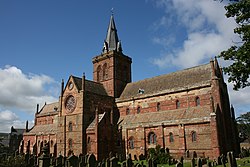Kirkwall
| Kirkwall | |
| Orkney | |
|---|---|
 St Magnus Cathedral | |
| Location | |
| Island: | Mainland |
| Grid reference: | HY449109 |
| Location: | 58°58’52"N, 2°57’36"W |
| Data | |
| Population: | 8,686 (est) |
| Post town: | Kirkwall |
| Postcode: | KW15 |
| Dialling code: | 01856 |
| Local Government | |
| Council: | Orkney |
| Parliamentary constituency: |
Orkney and Shetland |
Kirkwall is the largest town and capital of Orkney. A royal burgh, it stands in the middle of Mainland, where the island is pinched to north and south leaving a narrow gap between Kirkwall on the north coast and Scapa on the south. Though a mighty town in the context of the islands, Kirkwall is by other standards small and quiet. It bears reminders of the great power once wielded here, in particular the vast St Magnus Cathedral, built by the Norse Earls of Orkney, and beside it, now decayed to ruin, the Earls' residence, while wandering lanes join the town together.
Kirkwall is first mentioned in Orkneyinga saga in the year 1046 when it is recorded as the residence of Rögnvald Brusason the Earl of Orkney, who was killed by his uncle Thorfinn the Mighty. In 1486, King James III of Scotland elevated Kirkwall to the status of a royal burgh; modern roadsigns still indicate "The City and Royal Burgh of Kirkwall".
The name Kirkwall is derived from the Old Norse name Kirkjuvagr, meaning "Church Bay".
The town


Kirkwall stands on the northern coast of Mainland and has a population of about 8,500. Its harbour serves fishing boats and ferries; from here cargo ships and ferry services sail south to Aberdeen and north to Lerwick and serve Orkney's northern islands.
St Magnus Cathedral at the heart of the town was founded in memory of Saint Magnus Erlendsson, Earl of Orkney 1108-1117 by a successor, Rögnvald Kali Kolsson, Earl of Orkney. The bones of both Magnus and Rögnvald lie entombed in pillars in the Cathedral. Next to the Cathedral are the ruins of the former Bishop's Palace and Earl's Palace, each abandoned since earls ceased to rule and office of bishop was abolished form the Kirk.
The town has two museums: Tankerness House Museum, which is contained within one of Scotland's best-preserved sixteenth century town-houses, contains items of local historical interest. The prehistoric, Pictish and Viking collections are of international importance. The other museum is the Orkney Wireless Museum, dealing with the history of radio and recorded sound.
Apart from these main historical buildings, Kirkwall has many 17th-18th century houses and other structures in the local vernacular style. The 'Kirk' of Kirkwall was not the Cathedral (which was originally at Birsay), but the 11th century church of Saint Olaf of Norway. One late mediæval doorway survives from this church, and an aumbry from the original church survives within the late 19th Century structure of the present-day Saint Olaf's Church (of the Scottish Episcopal Church) in the town's Dundas Crescent. Kirkwall also once had a mediæval castle, which was destroyed in the 17th century.
On the west edge of the town, surrounded by Hatston Industrial Estate, is a prehistoric ancient monument, Grain Earth House (Historic Scotland), a short low stone-walled passage deep underground leading to a small pillared chamber. This is the form of earth house or souterrain characteristic of the Northern Isles (although Grain is unusually deep below ground). It was originally connected to a surface dwelling, which has since disappeared, and the original purpose of these Iron Age structures remains unknown. The key for the monument comes from Ortak Visitor Centre and Factory.
Kirkwall also has the most northerly of the world's Carnegie libraries, which was opened by Andrew Carnegie and his wife in 1909. The building survives, although the library itself has since moved to a larger building on Junction Road.
The Ba
The Ba Game is one of the major annual events in the town. The game is held each Christmas Day and New Year's Day between the Uppies and the Doonies, each team representing one half of the town. It is one of the last survivals of "village football" in the land.[1] The two sides, the Uppies and the Doonies, are more correctly the "Up-the-Gates" and "Doon-the-Gates" from the Norn gata (road). Recent housing developments favour the Uppie side to the point the Doonies are outnumbered almost 2-1 in modern games, and have only won a single game from 1998 to 2007. Up to 200 players take part in each game. The Ba is the ball.
The Men's Ba is thrown up at 1 o'clock at the Market Cross on the Kirk Green opposite the Cathedral and as the bells chime, the Ba disappears into the scrum, which then surges in a mob up and down the streets.
The Doonies goal is the sea, normally within the Basin of the Harbour, but so long as it is immersed in the salt water of Kirkwall Bay, the Ba has gone doon. The Uppies must round the Lang, or Mackinson's Corner at the junction of Main Street with New Scapa Road. Once Up or Doon, an individual winner is acclaimed, after much forthright debate. To Ba enthusiasts the ultimate honour is to have the trophy of the game, the Ba itself, hanging in the living room window.
References
- ↑ Saslow, Eli (2007-12-30). "Tradition: The Old Ba' Game". The Washington Post. http://blog.washingtonpost.com/why-we-compete/2007/12/tradition.html.
Outside links
| ("Wikimedia Commons" has material about Kirkwall) |